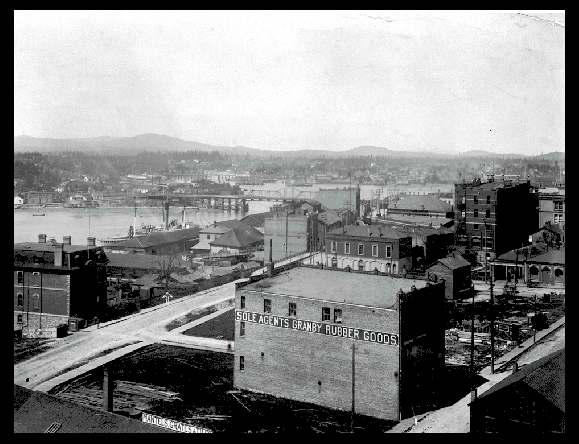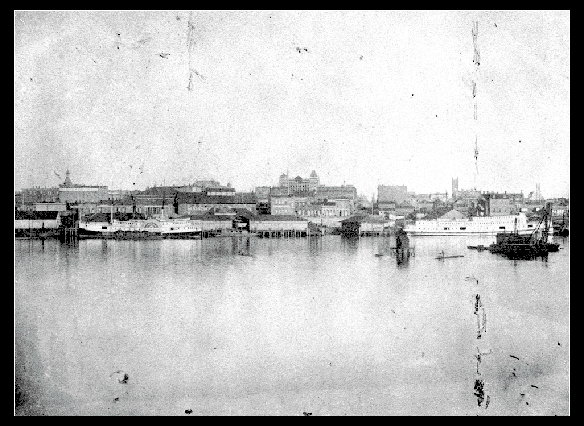Historical Background of Victoria
General Progress on Wharf Street
List of Wharf Street Businesses
Description and Nature of the City
In Book of Small, Emily Carr, local resident and artist, described her early impression of Victoria as follows:
Victoria was like a lying-down cow, chewing. She had made one enormous effort of upheaval. She had hoisted herself from a Hudson’s Bay Fort into a little town and then she paused, chewing the cud of imported fodder, afraid to crop the pastures of the new world for fear she might lose the good flavour of the old to which she was deeply loyal. Her jaws went rolling on and on, long after there was nothing left to chew.8
Carr recalled that Government Street was the main street in town, and that there was a little grouping of shops where Fort Street intersected with Government. Yates, Broad, and View Streets also housed shops, as well as livery stables, and a great number of saloons. The Court House and jail were located on Bastion Street and down on Wharf Street were the wholesale businesses.9 Carr also recalled “the smell of horse manure was so much a part of very street that it sat on your nose as comfortably as a pair of spectacles.”10
During this time, business directories were published to generate pride and assurance among local businessmen and to attract outside investment. Pages from the Williams’ Directory provide a glowing description of Victoria in the early 1880s. Despite the directory's sole focus on the positive features of the city, it offers useful insights into the nature of the city during these early years. Victoria was an important city during the 1880s as it was the first seaport on the northwest coast north of San Francisco. However, in 1881 the harbour was incapable of accommodating ships that drew more than eighteen feet of water. According to the directory, one of the many advantages of the city was its close proximity to rolling hills, romantic scenery, and an abundance of game and fish for the sportsman. Much of the description focused on the natural beauty and picturesque quality of the area, including Beacon Hill Park, the Gorge, and the snow-capped view of the Olympic Mountains, as well as the mild and agreeable temperature. Across the harbour was the First Nations reserve occupied by the Lekwammen people, then known as the Songhees Indians.11
In 1881,
signifying Victoria’s new position as a province in the Dominion
of Canada, there were five government buildings, built from red brick
and based on a Swiss style of architecture. Furthermore, there were Dominion
buildings which housed the federal offices, including the Custom House,
the Post Office, and the Marine Hospital. Most of the businesses in the
commercial part of town were well built of brick and stone, many exhibiting
good taste and quality architectural skill. In contrast, the private homes
were mostly wooden. Many of which were surrounded
by orchards, luxuriant gardens, and an abundance of flowers.12
Victoria had direct mail contact with San Francisco three times a month
through mail steamers, and overland communication with Portland, Oregon.
Due to the busy coastal trade, there was consistent communication with
ports in Oregon and California. There were two weekly newspapers and three
daily ones. A recent addition was a steamer from England to transport
freight and passengers between Victoria and San Francisco. The city remained
connected to the mainland via a submarine telegraphic cable across the
Gulf of Georgia from Nanaimo. Victoria boasted an abundant water supply
acquired from Elk Lake. The city was equipped with gas, and electric lights
were introduced in 1884. Coal and wood fuel were both abundant and moderately
priced. The presence of services such as gas and
piped water were representative of the increasing permanence of settlement
during this period. The manufacturing industry was described as
thriving and included businesses such as iron and brass works, soap works,
boot and shoemakers, as well as match, cigar, and glove factories.13
Further indications of the changing nature of the city from the days of
the Hudson’s Bay Company domination and the gold rush were found
in the directory’s appeal to travellers and
tourists. Horses and carriages were readily available for hire
at good rates for sightseeing and hotel accommodations were comfortable
and reasonably priced. The directory concluded with a final appeal to
potential visitors and investors when it stated:
The visitor to Victoria will find in his experience that, in the short summary that has been given, the local attractions of the neighborhood have not been over-stated. On the other hand the steady progress which has of late been witnesses must dispel from the minds of Victorians themselves the misgivings which for a time may possibly have been entertained; while the prospect of the early completion of the railway now in progress, gives, in connection with other public works, assurance of continued prosperity.14
Victoria Harbour Showing Johnson and Wharf Street - 1880
View of Victoria Waterfront and Wharf Street from the Songhees Reserve - 1890s

